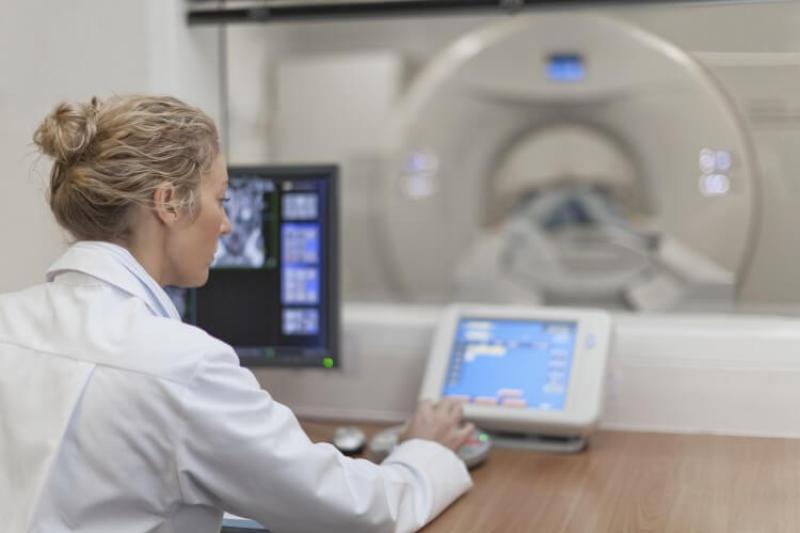- AdventHealth University

Working in the medical field yields a myriad of benefits for healthcare professionals; however, individuals don’t necessarily have to spend years in medical school to make a difference in the lives of patients. Imaging technologists can enter the field with an associate or bachelor degree. With this education, they can help diagnose and monitor medical conditions through various forms of imaging technology.
Imaging technologists who are interested in pursuing different types of medical imaging modalities, enhancing their skills and knowledge, and advancing their careers, should consider a bachelor’s in imaging sciences.
Types of Medical Imaging Technologies
Physicians and primary care providers regularly choose to order a particular medical imaging exam based on a patient’s symptoms and potential diagnoses. By applying their knowledge of technology and human anatomy, medical imaging technologists capture targeted images, enabling healthcare professionals to examine areas of a patient’s body for signs of illness or disease. Several types of medical imaging technologies are used in various facets of medicine.
Computed Tomography
Computed tomography, often referred to as CT or CAT scanning (Computerized Axial Tomography), is a medical imaging technology that uses X-ray radiation. Images are created when X-rays pass through a patient’s body and specialized detectors capture the exiting X-rays, converting this information to a visible image. Computed tomography scans take several images through continuous sections of a patient’s body or body part. This creates a set of cross-sectional images that provide information about bones, tissues, and blood vessels.
Computed tomography scans can be more effective than plain X-rays because they are more detailed, but they do require higher doses of radiation. Doctors often use CT scans to diagnose internal injuries after an accident, locate a tumor, or detect a disease such as cancer. CT scans can also help doctors monitor a patient’s progress in recovering from an injury, such as a broken leg, or from a condition, such as heart disease.
Magnetic Resonance Imaging
Magnetic resonance imaging (MRI) utilizes superconducting magnets and radio waves to form images rather than ionizing radiation. An MRI machine consists of a large magnet that creates a magnetic field. An MRI scan uses a strong magnetic field and radio waves to generate images of organs and tissues. Doctors choose to use MRI when they want to analyze a patient’s ligaments and tendons, soft tissues, or organs. MRI of the brain can help doctors diagnose strokes, tumors, eye disorders, aneurysms, and other conditions.
A physician may use MRI to examine the size of a patient’s heart, the effects of a heart attack, or the inflammation of blood vessels. Magnetic resonance imaging can also help doctors detect tumors or cancer in a patient’s liver, breast, ovaries, kidney, pancreas, and other organs.
Vascular Interventional Radiography
Vascular interventional radiology allows doctors to treat various conditions through angioplasty, stenting, thrombolysis, and other minimally invasive procedures. Vascular interventional radiology can utilize multiple techniques and imaging processes, including computed tomography, ultrasounds, and X-ray fluoroscopy.
Many vascular interventional radiology procedures involve an interventional radiologist passing a needle through a small incision in the patient’s skin to the treatment location. Some procedures involve small catheter tubes or wires that doctors can use to navigate through a patient’s body. Vascular interventional radiology helps doctors treat blood vessel disease, resolve issues in dilated or blocked veins, guide benign tumor therapies, and remove kidney or gallbladder stones.
Sonography
Sonography is a form of medical imaging, also known as ultrasound imaging, that relies on sound waves. Ultrasound technologists place gel on the location where they are going to capture an image. A probe, known as a transducer, is then placed on or inside the patient’s body. In order to create images, sound waves are sent into the body and reflected back into the transducer, which generates electrical signals that are converted to visible images. The process does not involve any radiation, but produces a real-time moving image.
Doctors often use sonography to check on fetal growth and development. Ultrasound examinations can also help diagnose conditions when a patient has symptoms relating to pain, swelling, or infection. Doctors use ultrasounds to examine a patient’s heart, gallbladder, liver, kidneys, brain, spine, and other organs.
Types of Medical Imaging Career Options
Imaging technologists who are interested in learning and working in new types of medical imaging modalities can explore the following career options.
Computed Tomography Technologist
Computed tomography technologists are responsible for performing a wide range of CT procedures. They ensure the safety of patients during the procedure, administer contrast media if needed, select the proper imaging protocol, and monitor patients after the exam. Computed tomography technologists should earn a bachelor’s degree in the field and must become certified in computed tomography through the American Registry of Radiologic Technologists (ARRT). According to the compensation website PayScale, computed tomography technologists earn a median annual salary of $63,106.
Magnetic Resonance Imaging Technologist
According to the U.S. Bureau of Labor Statistics (BLS), 61% of MRI technologists work in hospitals. They can also work in medical and diagnostics labs, physicians’ offices, or outpatient care centers. MRI technologists can begin their careers by earning an associate degree or bachelor’s degree. They can become certified through either the American Registry of Magnetic Resonance Imaging Technologists or the ARRT. The job outlook for MRI technologists is projected to grow 7% between 2019 and 2029, according to the BLS, and the annual median salary is $62,280.
Vascular Interventional Radiographer
Vascular interventional radiographers assist radiologists with minimally invasive procedures such as angioplasty, stenting, and thrombolysis. Professionals who work with this type of medical imaging process use fluoroscopic equipment to capture internal images of patients. They work in hospitals, labs, clinics, or outpatient care centers. Like CT technologists, they should earn a bachelor’s degree in the field and must become certified in vascular interventional radiography through the ARRT. Vascular interventional radiographers earn a median annual salary of $72,260, according to PayScale.
Sonographer
Diagnostic medical sonographers prepare patients for ultrasound procedures and help interpret ultrasound images with doctors. They are responsible for maintaining sonography equipment as well as keeping organized records of patient images. Many sonographers choose to obtain their bachelor’s degree to stand out among the rest in their field, in addition to obtaining multiple credentials. According to the BLS, 61% of sonographers work in hospitals, but the highest paid sonographers are in outpatient care centers. Jobs for sonographers are projected to grow 17% between 2019 and 2029, according to the BLS, and the annual median salary is $74,320.
Earn a Bachelor of Science in Imaging Sciences
Pursuing a medical imaging career requires training, experience working with patients, and an educational background in the field. Some imaging technologists begin by going through a certification program or earning an associate degree. However, pursuing a bachelor’s degree, such as the Bachelor of Science in Imaging Sciences at AdventHealth University Online, can position imaging technologists for career advancement.
The imaging sciences program at AdventHealth University Online offers six specialty tracks: Imaging Leadership, Computed Tomography (CT), Magnetic Resonance Imaging (MRI), Vascular Interventional (VI), Sonography, and Interdisciplinary. Discover which type of medical imaging career is right for you.
Recommended Readings
The Most Common Medical Radiation Myths Dispelled
Radiologic Technologist vs. Ultrasound Technologist
Ultrasound Preparation: Tips for New Patients
Sources:
Medline Plus, Diagnostic Imaging
PayScale, Average Computed Tomography (CT) Technologist Salary
PayScale, Registered Technologist in Vascular-Interventional Radiography Salary
U.S. Bureau of Labor Statistics, Radiologic and MRI Technologists


